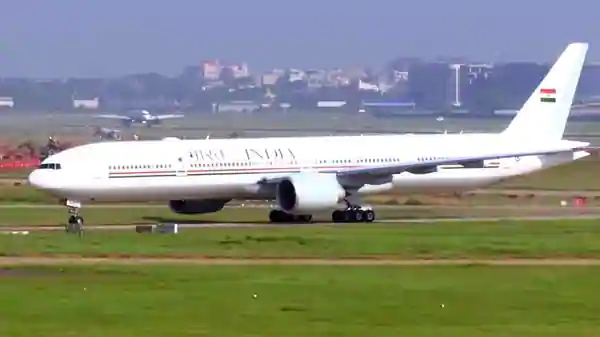
SOURCE: MINT
The second B-777 VVIP’s aircraft, Air India One landed at the Delhi airport on Saturday. Air India One aircraft is exclusively for the President, Vice President and Prime Minister. The first of the two VVIP aircraft Air India One arrived in India earlier this month.
Earlier in August, contingents of senior officials of Air India, security officers, and senior government officials visited the United States to accept the delivery of the SESF or VVIP aircraft Air India One.
Air India One is equipped with an advanced and secured communication system that allows availing audio and video communication functions mid-air without any worries of hacking or being taped, sources familiar with the details told ANI earlier.
The VVIP aircraft B-777 is a replacement of wide-body aircraft Boeing B-747 jumbo aircraft whose call sign is Air India One. The interior design of the aircraft is very attractive, which was modified recently by Boeing, apart from other customisations.
The new Boeing 777 aircraft for VVIPs guest is also equipped with advanced defence systems and will be operated fully by IAF pilots in due course of time.
The colour of Air India Boeing 777 had been totally changed including changes to the design of the aircraft as per the recommendations and further approval by the Prime Minister’s Office (PMO).
Mr. Modi’s efforts to strengthen ties with partner countries—especially the others in what is called the Quad group, Australia, Japan and the U.S.—are aligning with the Trump administration’s much more assertive approach to China, said Harsh V. Pant, head of strategic affairs at Delhi-based Observer Research Foundation, which describes itself as a nonpartisan, independent research organization that promotes a “strong and prosperous India in a fair and equitable world.”
“The fact that the U.S. is spending so much diplomatic capital on enhancing ties with India when an election is a week away underscores the growing maturity of Indo-U.S. engagement and the fact that China’s rise is a challenge that cannot wait for the electoral cycle to get over,” said Mr. Pant.
The U.S. and India have grown closer over the past two decades, starting with a landmark political deal that legitimized India’s nuclear arsenal and opened the door to sales of civilian nuclear technology from the U.S.
From essentially zero dollars in defense cooperation in 2008, India-U.S bilateral defense trade has grown to more than $20 billion in 2020, according to the State Department. American aviation and aerospace companies such as Boeing Co. and Lockheed Martin Corp. , as well as U.S. suppliers of arms and ammunition, have pursued business opportunities in India.
During the first “2+2” dialogue of top defense and foreign-policy officials in 2018, the two countries signed an agreement to allow the sharing of encrypted military intelligence. The two nations have also signed the Logistics Exchange Memorandum of Agreement, which permits their respective militaries to replenish materiel and fuel from each other’s bases.
Still, India has traditionally emphasized its nonaligned status, and most experts don’t think New Delhi is likely to become an official treaty ally of the U.S. in the same way as Australia, Japan or South Korea.
“The U.S. and India will need to craft their security partnership in a way that it stays out of the alliance system,” said Michael Kugleman, senior South Asia expert at the Wilson Center, a nonpartisan Washington policy think tank chartered by Congress. “The Quad offers one such pathway: It binds together four like-minded nations that are increasingly willing to engage in maritime cooperation.”
The U.S. is also looking for better maritime cooperation with island countries in the Pacific and Indian Oceans as China seeks to press its own claims and boost Beijing’s influence through its Belt and Road initiative, focused on building infrastructure and trade.
“We are enforcing what has been long known as international law and preventing folks from trying to dominate or monopolize access to any particular area,” said David Stilwell, assistant secretary of state for the Asia-Pacific, told reporters Thursday.
After New Delhi, Mr. Pompeo is set to visit Colombo, the largest city in Sri Lanka, and meet Prime Minister Mahinda Rajapaksa, a politician seen as friendly to China.
“We encourage Sri Lanka to review the options we offer for transparent and sustainable economic development in contrast to discriminatory and opaque practices,” said Dean Thompson, a State Department official overseeing South and Central Asian affairs.
Then Mr. Pompeo has a stop in Male, the capital of the Maldives, an island country in the Indian Ocean. The visit comes just weeks after Maldivian and U.S. defense officials signed a cooperation agreement.
Mr. Pompeo will then meet President Joko Widodo in Jakarta. The Trump administration has sought to defend the maritime and fishing claims of Indonesia and other Southeast Asian nations against competing claims by China.
“Rules provide the grease between countries so we don’t have unfortunate incidents,” Mr. Stilwell said. “So again, our support for not just Indonesia but all the claimant states in Southeast Asia and pretty much everywhere provides that, prevents instability and conflict.”






